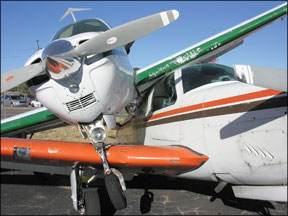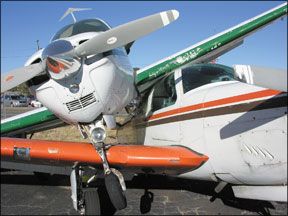Everyone remembers their first solo flight. Mine was memorable for two reasons. First, the Cessna 150 I was flying had a habit of allowing its right-side window to pop open, seemingly at will. Of course, the airplane “willed” the window open 288 shortly after I became airborne on my third touch and go. Reaching across the 150s “cabin” to pull it closed wasnt a crisis, but it wasnt something I wanted to be doing right then, either. The other memorable part of my first solo was fitting the 150 into the traffic flow. The non-towered airport had three runways, laid out in the WWII training-field triangle still so common throughout the southeast U.S. I was using Runway 21; a Baron was inbound for Runway 15 and someone else was a factor, perhaps on Runway 27. All of these aircraft were much faster than mine and, by definition, were being flown by more-experienced pilots. Still, all of us managed to fly proper patterns to our respective runways I was the last to land, unsurprisingly and no sheet metal got bent. And, yes, I still have the shirttail the local hangar rats clipped that day. I tell this tale not to reminisce but to illustrate that flying a traffic pattern and fitting into the flow at the local non-towered airport isnt rocket science. If an eight-hour primary student on his first solo can do it, so can everyone else. But too many of us either forget how to safely and courteously fly a pattern or adopt an attitude, thinking their airplane is the most important one and that they have to be on the ground first. It doesnt have to be that way. The Basics Im not going waste time describing or debating the FAA-recommended rectangular traffic pattern sorry. If youre not familiar with traffic pattern basics, nows a good time before you go out to the airport for your next flight, please to sit down with some training materials or the Aeronautical Information Manual and refresh yourself. However, let me highlight some of the stuff pilots need to do to prepare for operations at a non-towered airport. Perhaps the easiest mistake pilots make and seemingly one of the most common is a failure to plan for the pattern. Basic information like field elevation, pattern altitude, CTAF and which way to turn in the pattern is necessary to do this correctly. If you dont know where this stuff can be found, or you dont know what to do with it, make plans right now to huddle with an instructor and revisit your preflight planning skills. With resources like the Internet, airborne databases and the FAAs Airport/Facility Directory, theres simply no excuse for not having this basic information in hand and plugged into your communications radio well before approaching the airport. Once we know these basics, its time to get set up for the pattern. Plug the CTAF into the radio you plan to use and, presuming youre not talking to ATC or someone else, make it active. But before you do anything else, listen. Patiently listening to whats going on at the airport youre approaching is the best way to get a mental picture of the traffic level, its flow, the runway in use and where youll probably fit into the pattern. For example, if there are three trainers plodding along and youre flying a faster airplane, youll need to get slow well before leveling off at pattern altitude. Depending on how clean a bird youre flying, that could take some time and miles. Planning is your friend. Of course, if listening for a few minutes while approaching your destination doesnt result in any useful information, its time to make a radio call. Please dont transmit the overly hopeful “any traffic advise” nonsense: Just because no one answers doesnt mean no ones there. Instead, call the facilitys Unicom. If theres still no answer, transmit in the blind to the airports traffic your position and intentions. Usually, if theres someone in the area, and theyre listening, theyll answer. Of course, youre on the correct frequency and the volume is turned up, right? And, if you dont know what to say in such a blind call, you probably shouldnt be there in the first place. Do some research. Entry/downwind Planning is also your friend once you know which runway is in use and, based on the patterns direction, where youll need to enter it. For our purposes, lets presume youll be doing the standard, FAA-recommended 45-degree entry to the downwind leg. By this time, you want to be at or very near pattern altitude and relatively close to the airport. You should be able to see it (this is, after all, primarily a VFR operation) and have a clear mental picture of your position relative to the pattern and how to gracefully enter it. With luck, youll also be able to pick out some of the traffic in the pattern. Pay very close attention to whats around you scan left and right, as well as below and in front of you, for other traffic. Especially if its a busy pattern, also scan the active runways departure area for closed-pattern traffic turning crosswind or someone entering the pattern from an extended downwind. This cant be emphasized enough: Since a traffic pattern is, also by definition, where youll find a high concentration of other aircraft, scanning for traffic is an imperative. Further, failure to scan and locate potential traffic conflicts is a leading cause of poor patterns, botched approaches and bad landings, not to mention mid-air collisions. But once youre established on the downwind, your task doesnt get any easier. In addition to flying and configuring the airplane while gauging your progress toward the runway, youve got to keep your head “on a swivel,” looking for other traffic: Just because youve made the correct, safe pattern entry doesnt men the next guy or gal will. Keep looking in the directions from which its likely conflicting traffic will appear, but look in the other directions, too. Dont forget to announce your pattern entry on the CTAF. Finally, a word about wide patterns versus narrow ones. Nothings more frustrating to the locals than the transient in the Bonanza who comes smoking in from the big city and then flies a downwind over the next county. Even the student in the Skyhawk can see the problems with a too-wide pattern. She also can turn well inside the Bo driver and be in the lounge sipping coffee by the time he lands. The problem only gets worse with faster, heavier airplanes. While theres no fixed pattern width or lateral distance from the runway at which the downwind should be flown the rule of thumb I use is to fly the downwind no further from the runway than I want to glide in the case of engine failure. From the standard 1000-foot pattern altitude, that means Im fairly close. If youre flying a 747, that might be too close. But youre not in a 747, or you wouldnt be trying to land at Cow Pie International. Slow down, close up the pattern and mix with the traffic. Its the right thing to do. Base/Final The closer we get to the runway, the greater the risk of a mid-air collision. Think about it: Traffic patterns funnel aircraft to the runway and, as you get closer to a landing, the funnel gets smaller. As the funnel narrows, there is less room to maneuver and whatever is being put through it gets jammed closer and closer together. At the end of the downwind leg, get ready to turn base. “Abeam the numbers” is the time-honored spot at which we earnestly begin configuring the airplane for landing. Depending on what youre flying, this means dropping gear, pulling off power, adding carb heat, extending a notch or more of flaps and re-trimming to establish an initial glide speed. It also means being absolutely clear on our sequence in the pattern, what traffic is in front of us and what is behind us. If, as often happens, someone announces a position in the pattern ahead of us, we had best visually acquire them before we either begin the descent from pattern altitude or turn base. The area between the numbers and the turn to base is a good spot for this exercise. When to turn onto the base leg? There are probably as many suggestions as there are instructors, but the one thing you never want to do is decide the point at which to turn base on a geographic landmark. Thats because, well, that landmark wont be there at any other airport. Duh. Best to use some other metric, such as time, altitude, angle of the runway relative to the airframe or our preferred method judgment. Once we complete the turn to base, its again time to configure the airplane, consider our progress and look for traffic. As the sidebars below and on the previous page illustrate, looking for traffic on the straight-in approach is always a good bet, especially when the weather makes an instrument approach a reasonable procedure for someone letting down from altitude. There youll find the turboprops and jets inbound from the runways instrument approach. Since they may have gotten a late frequency change from ATC, they may not have been able to make a call on the CTAF. They can also be on the wrong frequency or just plain ignoring you. Once weve determined the final approach path is clear, its time to turn final, the gauging of which is all about airmanship. Here, weve got to run a complicated equation involving the wind at our altitude, our position relative to the runway, our speed and altitude, and the touchdown point for which were aiming. Weve got to make the turn early enough that we dont over-bank, perhaps getting into a classic stall/spin on final, and we want to roll out with the nose pointed at the runway. Its not rocket science, but it does take some practice and judgment, along with the ability to fly the airplane while thinking about and doing something else. Once established on final, we complete the pre-landing checklist, double-check that the gear is down and the power controls are configured for a go-around and land. You dont need me to tell you how to do that. Roll your own/straight-ins Even though the FAA-approved traffic pattern has several components, once they are broken down and analyzed, its easy to see the logic. The basic traffic pattern works well as long as no one acts as if theyre alone. When someone 
Put another way, when someone decides to roll their own pattern, its a recipe for problems. Abbreviated downwinds, 180-degree and base-leg entries, flying a right-hand pattern when everyone else is on the other side of the runway and straight-ins are examples of these recipes.
The only “approved” maneuver of this bunch is the straight-in, which begs the question: Why fly the straight-in? The answer varies, but can involve the airports instrument approach, the aircraft being flown or an emergency. By far, a full pattern is preferred, not just out of courtesy but because it gives us plenty of opportunity to configure the airplane along with several visual cues.
But none of these tips will really matter if we dont pay attention to whats going on around us. Look for traffic and especially look where the traffic typically will be. That way, you can avoid a Bonanza sandwich. Or worse.




